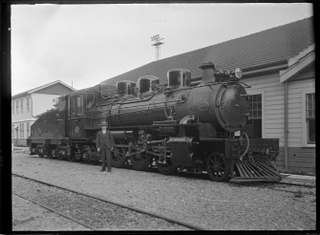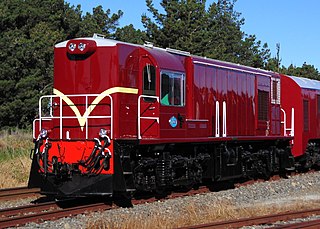Related Research Articles

The Ferrymead Railway is a New Zealand heritage railway built upon the track formation of New Zealand's first public railway, from Ferrymead to Christchurch, which opened on 1 December 1863. On the opening of the line to Lyttelton on 9 December 1867, the Ferrymead Railway became the Ferrymead Branch and was closed shortly thereafter. In 1964, rail enthusiasts began relaying track on the historic formation and the new 3 ft 6 in narrow gauge. Ferrymead Railway officially reopened in 1977. It now operates steam, diesel and electric trains regularly and is recognised as one of the most significant rail preservation sites in New Zealand.

Railway preservation in New Zealand is the preservation of historically significant facets of New Zealand's rail transport history. The earliest recorded preservation attempt took place in 1925, although the movement itself did not start properly until 1960.

Ferrymead Heritage Park is a museum in Christchurch, New Zealand, housing groups with historical themes, mainly transport related. Formerly known as Ferrymead Historic Park, it was founded in 1964 by groups, local government bodies and other interested parties. It is in the Heathcote Valley, at the site of New Zealand's first public railway.
The Canterbury Railway Society is an organisation of railway enthusiasts based in the Canterbury region of New Zealand's South Island, best known for their operation of The Ferrymead Railway at the Ferrymead Heritage Park.

The New Zealand F class was the first important class of steam locomotive built to operate on New Zealand's railway network after the national gauge of 3 ft 6 in was adopted. The first locomotives built for the new gauge railways were two E class double Fairlies for the Dunedin and Port Chalmers Railway Company. The F class was the first class ordered by the central government, and between 1872 and 1888, a total of eighty-eight members of the class were constructed.

The NZR A class of 1873 consisted of three types of steam locomotives used on New Zealand's railway network of similar specification but differing detail. The first and most numerous were from the Dübs and Company, the next from the Wellington firm E.W. Mills Lion Foundry, and the last from the Scottish firm of Shanks. The specifications are for the Dubs Yorkshire engines.
Locomotives of New Zealand is a complete list of all locomotive classes that operate or have operated in New Zealand's railway network. It does not include locomotives used on bush tramways.

The NZR WD class was a class of tank locomotive built by Baldwin Locomotive Works to operate on New Zealand's national rail network.

The NZR E class of Double Fairlie steam locomotives were two different types of Fairlie steam locomotives, used on New Zealand's railway network.

The NZR RM class Edison battery-electric railcar was a railcar that ran in Canterbury, New Zealand for eight years. It was built for New Zealand Railways (NZR) as a prototype for battery-electric railcars. While the railcar, classified "RM 6", was considered the first successful railcar in New Zealand, it was later destroyed in a fire, and battery-electric traction for railcars was not developed further in New Zealand. Two other classes of battery-electric locomotives were introduced about the same time as RM 6, the E class of 1922 and the EB class of 1925.

The NZR C class tank locomotives operated on New Zealand's national rail network during its infancy. They are sometimes referred to as the little C class or the original C class to distinguish them from the C class of 1930.

The NZR C class consisted of twenty-four steam locomotives built to perform shunting duties on New Zealand's national rail network. It is sometimes known as the big C class to differentiate it from the C class of 1873.

The New Zealand DI class locomotive was a class of diesel-electric locomotive in New Zealand. They were built by English Electric at their plant in Rocklea, Queensland in Australia. The class is very similar to the Queensland Railways 1620 class locomotives. At the time of their introduction, the class was seen as an alternative to the DB class for use on lightly laid secondary and branch lines, more so in the South Island. The World Bank financed introduction of the Japanese built DJ class in 1968, which ensured that no further DI class locomotives were purchased by New Zealand Railways.

The New Zealand EW class locomotive was a type of electric locomotive used in Wellington, New Zealand. The classification "EW" was due to their being electric locomotives allocated to Wellington. For two decades until the advent of the DX class they were the most powerful locomotives in New Zealand.

The New Zealand DE class was a class of fifteen diesel-electric shunting locomotives, introduced by the New Zealand Railways (NZR) with an intention to replace steam locomotives on shunting duties with diesel power. The class was physically similar to the Tasmanian Government Railways X class, which was also of English Electric design.

The NZR W class consisted of two steam locomotives built at the Addington Railway Workshops in Christchurch, New Zealand by the New Zealand Railways Department (NZR). They were the first locomotives to be built by NZR.

Steam Incorporated, often abbreviated to Steam Inc., is a railway heritage and preservation society based at the Paekākāriki railway station, Paekākāriki at the southern end of the Kāpiti Coast, approximately 50 minutes north of Wellington on the west coast of New Zealand's North Island. Unlike some societies who operate on preserved sections of closed branch lines, Steam Incorporated owns a depot beside one of the country's most important railway lines, the North Island Main Trunk railway, and restores heritage locomotives and rolling stock for use on excursions on the regular national rail network.
The Diesel Traction Group (DTG) is the Christchurch-based operator of a fleet of ex-New Zealand Railways Department diesel-electric locomotives. The fleet represents a full collection of New Zealand locomotive classes built by the English Electric Company and is a historically significant collection of early New Zealand diesel traction. All of the DTG's locomotives are owned by individual members through the sale of shareholdings.
The Tramway Historical Society Inc. is located at the Ferrymead Heritage Park in the Christchurch, New Zealand suburb of Ferrymead and operates the standard gauge Ferrymead Tramway. Trams have operated at Ferrymead since 1968, with progressive extensions built between 1970 and 1984 allowing trams to operate within the boundaries of the Heritage Park. The Society also operates and own a collection of historic trolley buses and diesel buses.
References
- ↑ "Ferrymead Heritage Park - Current Members - National Railway Museum of New Zealand Inc". 2024. Retrieved 13 April 2024.
- 1 2 "National Railway Museum of New Zealand". National Railway Museum of New Zealand. 2017. Retrieved 13 April 2024.
- ↑ "Register of Incorporated Societies - National Railway Museum of New Zealand Incorporated".
- 1 2 "Charity Services - National Railway Museum Of New Zealand Incorporated" . Retrieved 10 April 2024.
- ↑ "National Railway Museum". The Linesider: 59. March 2024. ISSN 2703-6197.
- ↑ "C Class history | Westport Railway Preservation Society". 20 January 2023. Archived from the original on 20 January 2023. Retrieved 9 June 2024.
- ↑ "National Railway Museum of New Zealand". www.facebook.com. 25 March 2024. Retrieved 9 June 2024.